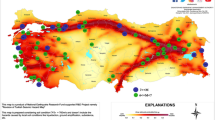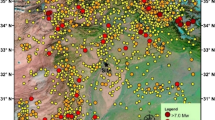Abstract
Afghanistan is situated close to the area where the Indian, Arabian, and Eurasian tectonic plates converge. The consequent seismic hazard causes the region to be repeatedly struck by major earthquakes. However, there is a lack of seismic instrumentation in the region, and only limited historical ground motions are available thus presenting a challenge for structural designers. Due to the absence of information and a database of ground motions, buildings in the region are often built without guidance from seismic codes. Consequently, the earthquakes in the region continue to cause enormous destruction to the built environment of the region. On 22 June 2022, the southeastern region of the country was struck by a major Mw 6.2 earthquake having a maximum modified Mercalli intensity of IX. In this study, synthetic ground motions are obtained using the modified stochastic finite fault methodology for Khost and Kabul cities in the region. The results from simulations obtained in the current study are observed to compare well with the available records of the earthquake. The obtained findings are reported as simulated accelerograms, acceleration response spectra, and Fourier response spectra, which will be immensely beneficial in understanding the behavior of the built environment of the region.












Similar content being viewed by others
References
United States of Geological Survey (USGS) 2022 accessed July 10, 2022 https://earthquake.usgs.gov/earthquakes/eventpage/us7000hj3u/executive
Shnizai Z, Talebian M, Valkanotis S and Walker R 2022 Multiple factors make Afghan communities vulnerable to earthquakes. Temblor. https://doi.org/10.32858/temblor.266
Waseem M, Lateef A, Ahmad I, Khan S and Ahmed W 2019 Seismic hazard assessment of Afghanistan. J. Seismol. 23: 217–242
Khalil U, Aslam B and Maqsoom A 2021 Afghanistan earthquake 2015 aftershocks analysis for a better understanding of the seismicity behavior for future assessment. Acta Geophys. 69: 1189–1197
Nasiry N Z and Aydan O 2019 Ground motion estimation at Kabul city for Mw 7.5 Hindu Kush earthquake, Rock Dynamics Summit, London, CRC Press
Yeats R S and Madden C 2003 Damage from the Nahrin, Afghanistan, earthquake of 25 March 2002. Seismol. Res. Lett. 74: 305–311
Majale M 2017 Afghanistan housing profile report, Minister of Urban Development and Housing of the Government of the Islamic Republic of Afghanistan
Barfield T 2022 Afghanistan: a cultural and political history. Princeton University Press
ANSA 2012 Afghan Structural Code (ASC), ABC/079, Afghan Building Code, Afghanistan National Standards Authority, Kabul, Afghanistan
Shareq A 1981 Geological observations and geophysical investigations carried out in Afghanistan over the period of 1972–1979. Zagros Hindu Kush Himalaya Geodyn. Evol. 3: 75–86
Boyd O S, Mueller C S and Rukstales K S 2007 Preliminary earthquake hazard map of Afghanistan. United States Geol. Sur. Open-File Rep. 1137
Ismail N and Khattak N 2019 Observed failure modes of unreinforced masonry buildings during the 2015 Hindu Kush earthquake. Earthq. Eng. Eng. Vib. 18: 301–314
Wheeler R L, Bufe C G, Johnson M L, Dart R Land Norton G A 2005 Seismo-tectonic map of Afghanistan, with annotated bibliography, United States Department of the Interior, United States Geological Survey
Anggraeni D 2010 Modelling the impact of topography on seismic amplification at regional scale. University of Twente Faculty of Geo-Information and Earth Observation (ITC)
Dhabu A, Dhanya J and Raghukanth S T G 2018 Effect of Topography on Earthquake Ground Motions. Lect. Notes Civ. Eng. 107–117
Veeraraghavan S, Coleman J L and Bielak J 2020 Simulation of site and topographic effects on ground motion in Los Alamos, NM mesas. Geophys. J. Int. 220: 1504–1520
Imperatori W and Mai P M 2013 Broad-band near-field ground motion simulations in 3-dimensional scattering media. Geophys. J. Int. 192: 725–744
Lee S J, Komatitsch D, Huang B S and Tromp J 2009 Effects of topography on seismic-wave propagation: an example from northern Taiwan. Bull. Seismol. Soc. Am. 99: 314–325
Lee S J, Chen H W, Liu Q, Komatitsch D, Huang B S and Tromp J 2008 Three-dimensional simulations of seismic-wave propagation in the Taipei basin with realistic topography based upon the spectral-element method. Bull. Seismol. Soc. Am. 98: 253–264
Mohan K, Dugar S, Pancholi V, Dwivedi V, Chopra S and Sairam B 2021 Micro-seismic hazard assessment of Ahmedabad city, Gujarat (Western India) through near-surface characterization/soil modeling. Bull. Earthq. Eng. 19: 623–656
Incorporated Research Institutions for Seismology (IRIS) 2022 accessed August 07, 2022 Incorporated Research Institutions for Seismology, http://ds.iris.edu/wilber3/find_stations/11571439
Magenes G and Calvi G M 1997 In-plane seismic response of brick masonry walls. Earthq. Eng. Struct. Dyn. 26: 1091–1112
Mai P M and Beroza G C 2003 A hybrid method for calculating near-source, broadband seismograms: application to strong motion prediction. Phys. Earth Planet. Inter. 137: 183–199
Graves R, and Pitarka A 2004 Broadband time history simulation using a hybrid approach. In: Proceedings of the 13th World Conference on Earthquake Engineering, Canada, Paper No. 1098
Guatteri M, Mai P M and Beroza G C 2004 A pseudo-dynamic approximation to dynamic rupture models for strong ground motion prediction. Bull. Seismol. Soc. Am. 94: 2051–2063
Liu P, Archuleta R J and Hartzell S H 2006 Prediction of broadband ground-motion time histories: Hybrid low/high-frequency method with correlated random source parameters. Bull. Seismol. Soc. Am. 96: 2118–2130
Graves R W, Aagaard B T, Hudnut K W, Star L M, Stewart J P and Jordan T H 2008 Broadband simulations for Mw 7.8 southern San Andreas earthquakes: Ground motion sensitivity to rupture speed. Geophys. Res. Lett. 35: 1–12
Ghofrani H, Atkinson G M, Goda K and Assatourians K 2013 Stochastic finite-fault simulations of the 2011 Tohoku, Japan, earthquake. Bull. Seismol. Soc. Am. 103: 1307–1320
Aki K 1967 Scaling law of seismic spectrum. J. Geophys. Res. 72: 1217–1231
Hartzell S 1978 Earthquake aftershocks as Green’s functions. Geophys. Res. Lett. 5: 1–14
Beresnev I A and Atkinson G M 1998 Stochastic finite-fault modeling of ground motions from the 1994 Northridge, California, earthquake. I. Validation on rock sites. Bull. Seismol. Soc. Am. 88: 1392–1401
Motazedian Dand Atkinson G M 2005 Stochastic finite-fault modeling based on dynamic corner frequency. Bull. Seismol. Soc. Am. 95: 995–1010
Chopra S, Kumar V and Suthar Aand Kumar P 2012 Modeling of strong ground motions for 1991 Uttarkashi, 1999 Chamoli earthquakes, and a hypothetical great earthquake in Garhwal-Kumaun Himalaya. Nat. Haz. 64: 1141–1159
Vemuri J, Kolluru S and Chopra S 2018 Surface level synthetic ground motions for M7.6 2001 Gujarat earthquake. Geosci. J. 8: 429
Anderson J and Hough S A 1984 Model for the shape of the Fourier amplitude spectrum of acceleration at high frequencies. Bull. Seismol. Soc. Am. 74: 1969–1993
Author information
Authors and Affiliations
Corresponding author
Ethics declarations
Conflict of interest
The authors have no conflicts of interest to declare.
Rights and permissions
About this article
Cite this article
Chenna, R., Patnala, N., Vemuri, J.P. et al. Insights on the June 21, 2022, Khost earthquake, Afghanistan. Sādhanā 48, 144 (2023). https://doi.org/10.1007/s12046-023-02215-y
Received:
Revised:
Accepted:
Published:
DOI: https://doi.org/10.1007/s12046-023-02215-y




